The summer of braids is here, but how do you properly care for them?
Tips for braids done right
A Syracuse salon owner shares how to keep hair healthy while rocking a signature style.

As the weather heats up in Syracuse, Kayla Edelin has one rule for her summer hairstyle: no sew-in and no silk press.
“During the summer, it’s better to not even have to worry about your hair,” said Edelin, a Syracuse University public relations graduate student. “My hair would sweat out. The curls will come back and it would poof up.”
Instead, she chose Boho knotless braids. While braids are a popular protective style, any style that keeps your hair tucked away, for their low-maintenance appeal, some stylists say braids only offer protection with proper care.
What does humidity do to natural hair?
Humidity got a bad rep for broadcast and digital journalism graduate student Sydney Cuillier after too many fresh presses didn’t last the moment she stepped out of the salon.
“Give it 10 to 15 minutes, and my roots are back to my normal texture,” Cuillier said. “And that was a waste of time.”
Since then, braids have been her go-to and for others a summer staple to minimize frizz, shrinkage, puffiness and short-lived styles caused by humidity.
Humidity, the amount of moisture in the air, rises with heat, according to the National Weather Service. While moisture is essential for healthy hair, it causes styled hair to revert.

Hair naturally absorbs water from the air, causing the strands to swell and return to their natural state, according to a salon owner.
“ [Hair’s] kind of like a cloud,” said Gabrielle Lloyd, owner of The Divine Den, a salon at 524 Hawley Ave., which offers braiding among other beauty services.
Lloyd said braids will not repair damaged hair, however, installing them on already damaged hair can do more harm.
“It’s like trying to protect a burnt piece of paper,” Lloyd said. “It’s already crumbling.”
For braids to be protective, she said hair must be healthy beforehand and properly maintained throughout, but clients aren’t expected to assess their hair alone.
“For me, it’s important to find the balance of the condition that my client’s hair is in and what would work best for their lifestyle,” Lloyd said.
How to care for braided hair?
Lloyd suggests not keeping a braided style longer than six to eight weeks.
“Those two weeks, those are your honeymoon phase. You can enjoy it,” Lloyd said. “But the third week, you need to think about how you’re going to wash your hair.”
Washing hair while in a protective style helps prevent bacterial growth caused by the buildup of gel, oils and other hair products, Lloyd said.
She stresses the importance of moisture, noting that hair often goes without it while braided. She said some of her clients tend to avoid water to prolong their hairstyle.
“If you think about it, you would deprive your hair of water for two months,” Lloyd said..
Lloyd recommends a simple routine involving two spray bottles, one with diluted shampoo, the other with diluted conditioner.
Spray the solutions directly onto the scalp, rinse, let the hair air dry, then finish with a lightweight hair oil or mist to lock in hydration. Lloyd suggests this process be done every two weeks while braids are installed.
What are some protective hairstyle alternatives?
Protective styles aren’t limited to hairstyles with added hair, like boho knotless braids. They can be achieved using natural hair through styles like two-strand twists or cornrows.
Lloyd shares some of her go-to natural hairstyles, including the recently popular TikTok style inspired by influencer Jayda Wayda, braids in the front, and natural curls in the back. She also enjoys mini twists, box braids, flat twists or braided updos.
“Sometimes people need a break from the protective styles [with extensions] and actually just enjoy their natural hair,” Lloyd said.
